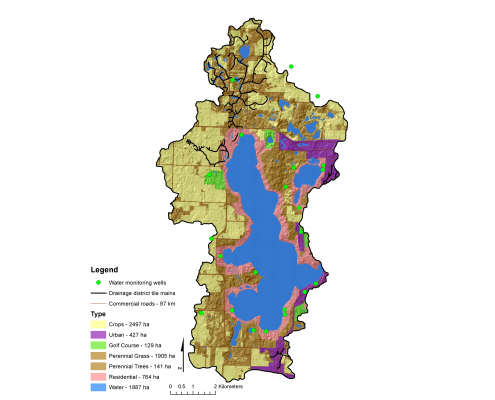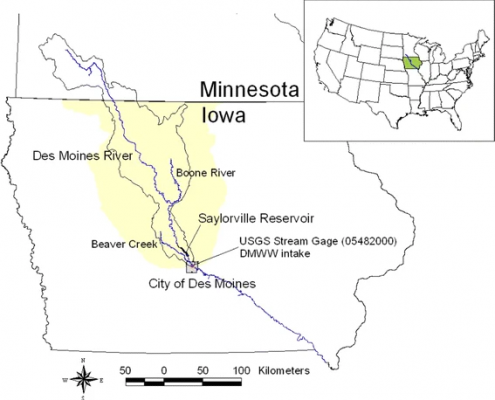Nonpoint source pollution from nitrate-nitrogen (nitrate) and phosphorus (P) is a major societal challenge in Iowa, contributing to nutrient enrichment in local streams and lakes and development of hypoxic (dead) zones in regional water bodies, including the Gulf of Mexico.
IGS researchers and collaborators use watershed analyses and models to investigate watershed processes and patterns and develop solutions for our water quantity and quality challenges. Led by State Geologist Keith Schilling and Matthew Streeter, the IGS examined nutrient loading patterns to groundwater near West Lake Okoboji and in the Clear Creek Watershed. In these studies, IGS developed the concept of “groundwater response units” to quantify groundwater loading patterns at a regional scale.
Projects
West Lake Okoboji, Iowa

Sponsor: Okoboji Homeowners Association
Background: IGS researchers used groundwater monitoring targeted to discrete land cover and landscape position across the basin to assess groundwater recharge and loading patterns.
Goals: Our objectives were to assess groundwater level fluctuations and nutrient concentrations under representative land use classes and to develop an allocation model for groundwater nutrient loads based on land cover class.
IGS Strategies: We installed monitoring wells at 21 locations around the lake and sampled throughout a three-year study period to understand how groundwater quality varied over the different land cover types.
Des Moines River Basin

Sponsor: Iowa Department of Natural Resources
Background: IGS watershed studies have sometimes incorporated the use of models such as the Soil Water Assessment Tool (SWAT) to quantify nonpoint source impacts at a watershed scale and analyze remedial scenarios. In this example, IGS analyzed nitrate loading patterns for the Des Moines River basin using SWAT.
Goals: To model streamflow and nitrate loads and evaluate a suite of basin-wide changes and targeting configurations to potentially reduce nitrate loads in the river.
IGS Strategies: IGS used SWAT to model streamflow and nitrate loads and evaluate a suite of basin-wide changes and targeting configurations to potentially reduce nitrate loads in the river. The SWAT model comprised 173 subbasins and 2,516 hydrologic response units and included point and nonpoint nitrogen sources. Researchers calibrated the model for an 11-year period and three basin-wide and four targeting strategies were evaluated.
More information: Results indicated that nonpoint sources accounted for 95% of the total nitrate export. The most efficient load reductions occurred when fertilizer applications were reduced in subbasins nearest the watershed outlet. The SWAT model results provide much needed guidance on how to begin implementing load reduction strategies most efficiently in the Des Moines River Watershed.
Recent Publications
Schilling, K.E., M.T. Streeter, D. Quade, and M. Skopec. 2016. Groundwater loading of nitrate-nitrogen and phosphorus to a large glacial lake, Iowa. Journal of Great Lakes Research, 42:588–598.
Schilling, K.E. and C.F. Wolter. 2009. Modeling nitrate-nitrogen load reduction strategies for the Des Moines River, Iowa using SWAT. Environmental Management 44:671–682.
Schilling, K.E., M.K. Jha, Y.K. Zhang, P.W. Gassman, and C.F. Wolter. 2008. Impact of land use and land cover change on the water balance of a large agricultural watershed: historical effects and future directions. Water Resources Research 44,W00A09, doi:10.1029/2007WR006644.
Schilling, K.E., P. Gassman, C. Kling, T. Campbell, M. Jha, and C. Wolter. 2013. The potential for agricultural land use change to reduce flood risk in the large midwestern watershed, USA. Hydrological Processes. DOI:1002/hyp.9865.
Drake, C.W., C.S. Jones, K.E. Schilling, A. Arenas Amado, and L.J. Weber. 2018. Estimating nitrate-nitrogen retention in a large constructed wetland using high-frequency, continuous monitoring and hydrologic modeling. Ecological Engineering 117:69–83.
McLellan, E., D. Robertson, K. Schilling, M. Tomer, J. Kostel, D. Smith, and K. King. 2015. Reducing nitrogen export from the Corn Belt to the Gulf of Mexico: agricultural strategies for remediating hypoxia. Journal of the American Water Resources Association, 51:263–289.
Jha, M.K., C.F. Wolter, K.E. Schilling, and P.W. Gassman. 2010. Assessment of TMDL implementation strategies for the Raccoon River, Iowa. Journal of Environmental Quality doi:10.2134/jeq2009.0392.
Contact Us

Keith Schilling
State Geologist and Research Scientist
PhD, University of Iowa
keith-schilling@uiowa.edu
319-335-1422
